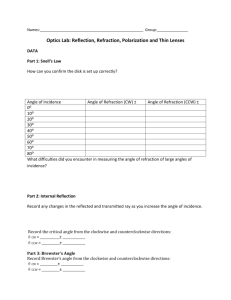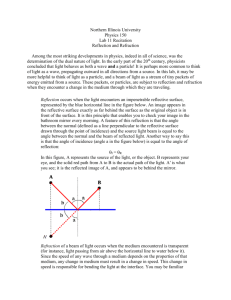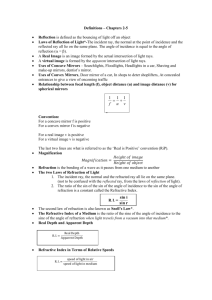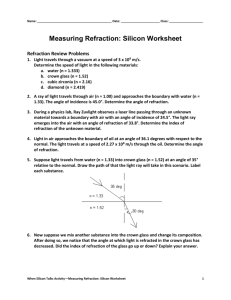Light Lab #2
advertisement
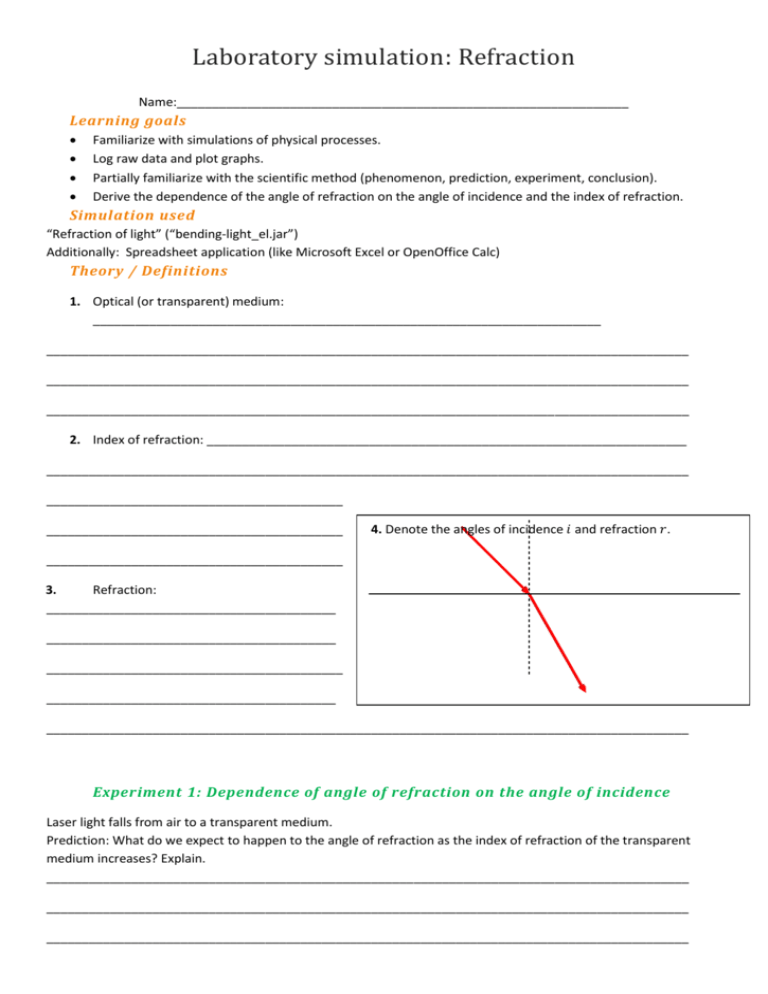
Laboratory simulation: Refraction Name:________________________________________________________________ Learning goals Familiarize with simulations of physical processes. Log raw data and plot graphs. Partially familiarize with the scientific method (phenomenon, prediction, experiment, conclusion). Derive the dependence of the angle of refraction on the angle of incidence and the index of refraction. Simulation used “Refraction of light” (“bending-light_el.jar”) Additionally: Spreadsheet application (like Microsoft Excel or OpenOffice Calc) Theory / Definitions 1. Optical (or transparent) medium: ________________________________________________________________________ ___________________________________________________________________________________________ ___________________________________________________________________________________________ ___________________________________________________________________________________________ 2. Index of refraction: ____________________________________________________________________ ___________________________________________________________________________________________ __________________________________________ __________________________________________ 4. Denote the angles of incidence 𝑖 and refraction 𝑟. __________________________________________ 3. Refraction: _________________________________________ _________________________________________ __________________________________________ _________________________________________ ___________________________________________________________________________________________ Experiment 1: Dependence of angle of refraction on the angle of incidence Laser light falls from air to a transparent medium. Prediction: What do we expect to happen to the angle of refraction as the index of refraction of the transparent medium increases? Explain. ___________________________________________________________________________________________ ___________________________________________________________________________________________ ___________________________________________________________________________________________ Set the angle of incidence at 𝟓𝟎𝝄 and leave it unchanged 2 Measure the angle of refraction 𝒓 Don’t change 1 Vary from 1.00 to 1.60 The laser is placed so that the angle of incidence equals 50 degrees. Table 1: Angle of reflaction vs the index of refraction Measurement Index of refraction 𝑛 Graph 1: Angle of reflaction vs the index of refraction Angle of refraction (degrees) 1 2 3 4 5 6 7 Conclusion compared to our prediction: ___________________________________________________________________________________________ ___________________________________________________________________________________________ Experiment 2: Dependence of the angle of refraction on the angle of inc idence Predictions/Hypothesis: What do we expect to happen to the angle of refraction as the angle of incidence increases? Explain. ___________________________________________________________________________________________ ___________________________________________________________________________________________ ___________________________________________________________________________________________ Vary the angle of incidence (𝟎𝝄 → 𝟗𝟎𝝄 ) 1 Keep unchanged 2 Measure the angle of refraction Graph 2: Angle of refraction vs angle of incidence Table 2: Angle of refraction vs angle of incidence Measurement 1 2 3 4 5 6 7 8 Angle of incidence (degrees) Angle of refraction (degrees) Conclusion compared to the prediction: ___________________________________________________________________________________________ ___________________________________________________________________________________________ ___________________________________________________________________________________________ Conclusion: Theory predictions versus the results of the 2 experiments. A number of scientists between the 10th and the 17th centuries (Sahl, Snellius, Descartes) concluded that the following formula should relate the angle of incidence 𝑖 with the angle of refraction 𝑟: 𝑠𝑖𝑛𝑖 = 𝑠𝑖𝑛𝑟 𝑛 Explain if the results of the 2 simulated experiments above are compatible with the formula. Experiment 1: __________________________________________________________________________________________ __________________________________________________________________________________________ _________________________________________________________________________________________ ___________________________________________________________________________________________ ___________________________________________________________________________________________ Experiment 2: ___________________________________________________________________________________________ _________________________________________________________________________________________ ___________________________________________________________________________________________ ___________________________________________________________________________________________ ___________________________________________________________________________________________ ___________________________________________________________________________________________




